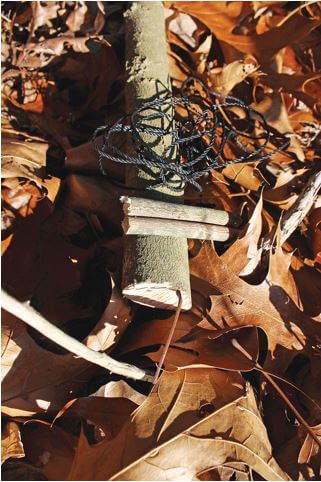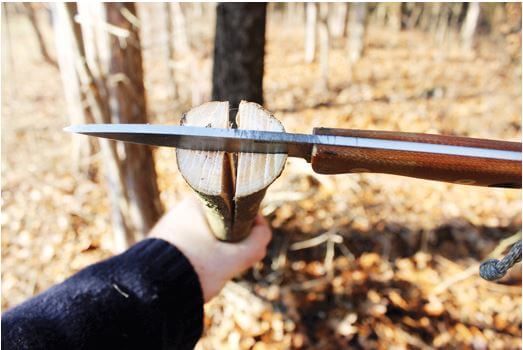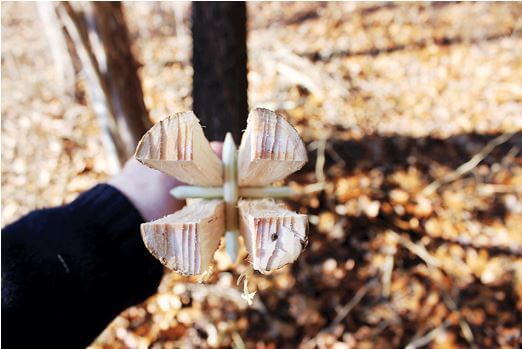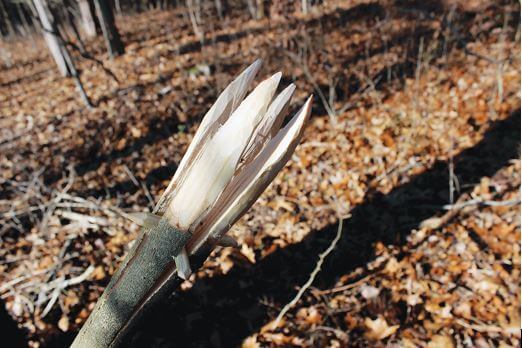How To Set A Small Animal Trap
Traps don't need to residual, nor do they need you to watch over them.
If yous happen to run out of food in the wild, you can subsist on fruit, vegetables and roots you lot might notice, but not for long. These foods are rich in trace minerals and vitamins, but don't provide the energy you need that comes from protein and fat. To survive in the wild, meat is necessary to meet your daily nutritional needs.
Hunting is a good fashion to support your survival nutrition, but if yous don't make whatever kills, yous will only be wasting precious fourth dimension and energy and hastening starvation. As such, line-fishing and trapping pocket-size game can be an attractive alternative.
Getting food this way has many advantages. If prepare at the right spots, snares and traps can efficiently provide food for you and your companions while requiring minimal effort.
Traps don't demand to rest, nor do they need you lot to watch over them. By setting several up at a time, it's like employing several hunters for complimentary, 24/7.
Don't be squeamish
When trapping modest animals for food, you lot tin can't afford to be picky. Be prepared to trap and consume animals yous've never eaten before. Birds, reptiles, rodents, fish, eels, worms, certain insects… basically anything that crawls, swims, flies, or slithers that has non-poisonous meat should be on the card.
The key discussion here is energy: the average developed American male needs betwixt 2,400 to iii,000 calories per 24-hour interval according to the USDA. As long equally your take hold of is edible and nontoxic, daily sustenance takes precedence over personal preferences and sense of taste.
The tools you'll need
To make the traps, y'all'll demand a survival knife, or at least annihilation that tin can cut or carve. Twine, rope, cord or metal wire can make good cutting implements. If you don't have rope, the roots of small trees like spruce are skillful substitutes.
Do your homework
Earlier you make and set upwards the traps, first you have to determine what sort of game is available to yous. Next, written report what kind of tracks they get out, what type of habitat they have, what time of 24-hour interval they're active and what sort of nutrient they eat.
Knowing what nutrient they eat is important, since yous'll have to allurement your traps. Here are a few tips for traps you tin set upwardly.
Snares
Snares consist of sturdy cloth fashioned into a noose, like twine, wire or thin rope, placed outside the game's den or on its trail. The noose must be big enough for the animal's caput to pass through and, depending on the construction, the snare may be triggered to "whip" the animal violently and break its cervix, or strangle it as it struggles to suspension free.
To make an constructive snare, you lot must know how to make a proper knot as well as a notched trigger if yous desire to employ one. You can increase your chances of success with a snare past using allurement.


Deadfalls
Deadfalls are traps that make utilise of hefty items, such as large rocks or logs, to crush an animal. A classic example is the Figure-Iv Deadfall. The name comes from the notched sticks that course the number "4".
The horizontal stick supports the rock or log while too holding the bait, thereby interim equally a weight trigger. For more detailed instructions on how to make an effective ambush trap, read this.

Bird Traps
While Deadfalls can take hold of birds, i type of trap is specifically made for winged game: the Pine Pitch Bird Cup. Note that you should simply apply this in a survival state of affairs, as it is considered an illegal and cruel method of trapping.
For this trap, all you demand is an empty coffee or dixie cup, some bait (like bird seed) and sticky pine sap or pitch. The original native version uses a pocket-sized cone of Birch tree bawl, stitched to course a cone.
The within is coated with sticky pino sap or pitch mixed with the bait. When a bird is attracted by the bait, its feathers get stuck in the pitch, holding it immobile until the trapper tin can collect it.
Pit Traps
The size of animals this trap tin can catch is limited simply by how big you arrive. The only drawbacks to this trap are that it takes a lot of energy to craft, and it must be placed close to a game trail.
Despite these drawbacks, it's a good trap to use due to its simple construction and efficiency. First, observe a trail where animals frequently laissez passer, as indicated by tracks, debris or disturbed vegetation. Dig a pit deep and wide enough to trap and hold the creature you want.
Place sharpened sticks at the bottom, then make a grill of sticks and branches to comprehend the pit. Hide the grill with leaves and grass.

Fish Traps
If you're shut to a river or stream, a fish trap is a surefire fashion of supplementing your diet with nutritious seafood. You can brand a uncomplicated and effective pool or shore fish trap by setting up rocks and some sticks to funnel and so "argue in" fish close to shore.
Exist sure to build the entrance of your trap opposite the current to prevent the fish from leaving when they enter your trap.
If yous're close to the ocean, the tidal flat trap tin can help you take reward of the tide's ebb and period. Brand a crescent-shaped wall of rocks during low tide, with the "tips" of the crescent pointing away from the body of water.
The wall should be built such that it extends outward and into the water. The wall should be high enough to stick out at low tide, trapping fish when the tide goes out.

The basket trap can work with or without the current, and with the added enticement of allurement. Information technology consists of flexible branches tied with vines or thinner branches in a cone or funnel shape. The basket trap is then tied securely to shore, or weighed down with rocks inside.
The entrance of the handbasket is lined with an inward-pointing cone, fooling the fish into thinking they can't become out. The advantage of these traps is the great results yous tin can get from relatively little effort.
The basket trap is a scrap laborious to make, just once it works, it'due south very sustainable and can be used again and again. Y'all can commencement with a pine cone to bait your first fish, then utilise its entrails to allurement the next fish, whose entrails in plough baits the next, then on.

For more detailed instructions on making the basket fish trap, use this guide.
Notes on Traps
Like existent estate, the key to effective traps is location. Gear up traps in areas where you can see show of game "traffic".
- Good spots to place traps include areas close to water sources.
- Your odour can put off animals from taking the allurement. Mask your own odor by blowing smoke on the trap, or rubbing mud, dirt or leaves on your hands when you handle the trap.
- Do non hang effectually and expect to see if your traps catch anything. Animals may pick upwardly your scent and stay away. Each time y'all ready a trap, leave the area.
- Check your traps every 24 hours for a successful catch. This is reasonable bridge of time to go any take hold of before it rots or other predators steal them.
- When not setting or checking your traps, use the time more constructively by foraging, shelter-building or other survival-essential tasks.
Hunting Gigs
While waiting for your traps to leap, make the almost of your time past hunting with an improvised pronged spear or "gig". This is a archaic tool for communicable fish.
To make a gig all you need is a sharp knife, a reasonably straight, spear-length stick, cordage and some twigs. First, cut a "+" into one finish of the stick to divide it into 4 equal quarters. Cut nearly v inches down the shaft of the stick, gently splitting it open so it forms four "prongs".
Next, go two twigs, inserting one after the other between the prongs and perpendicular to the shaft and each other, by lightly tapping i end of the twig while pressing the other end with your thumb. This will dissever the prongs, creating four opportunities to spear your prey. The twigs should be positioned about 3 inches from the cease of the shaft.
Sharpen all four prongs to a point. Strengthen the prongs by carefully turning them over a campfire. Practice this for virtually 10-15 minutes, making sure that the gig doesn't catch fire.
Once the prongs have sufficiently dried and toughened upwardly, secure the 2 pocket-size pegs with cordage, and wrap the gig with cordage for about ane inch on both sides of the twigs to preclude it from splitting open upon impact. Now you have a hunting gig to spear fish or any small animal you lot come across.
You tin see a more detailed guide to making gigs here.
Source: https://www.americanoutdoor.guide/survival-skills/survival-hunting-fishing/making-traps-for-small-game/
Posted by: szaboswely1945.blogspot.com





0 Response to "How To Set A Small Animal Trap"
Post a Comment